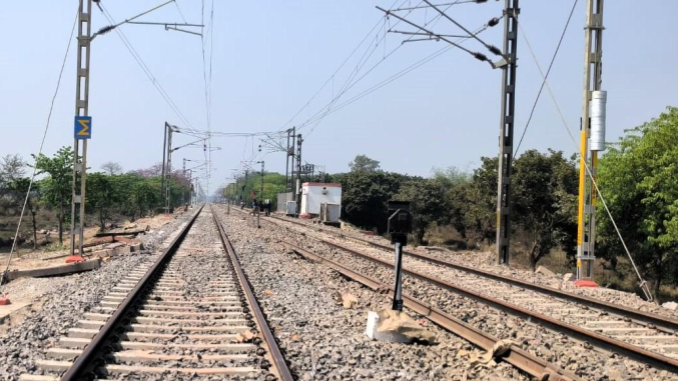
Indian Railways has electrified the Broad Gauge (BG) network of 60,814 km up to November, 2023 successfully, aligning itself with the target of becoming Net Zero Carbon Emitter by 2030. Electrification of 39,013 km has been achieved during April, 2014 to November, 2023.
More Details:
Indian Railways (IR) is committed to take steps for energy conservation and to increase energy efficiency. IR has also issued a comprehensive policy for adoption of energy efficiency measures in non-traction applications which, inter-alia, covers sustainable buildings; cloud based data monitoring and management portal; and energy efficiency in equipment and appliances. The policy also provides for procurement of Bureau of Energy Efficiency (BEE) 5 star rated equipment.
The 2,002 km BG network has been electrified during 2023-24 up to November’ 2023, including the 146 km BG network falling in the State of Maharashtra. Electrification of balance BG routes has been taken up.
Zone wise details of electrified network are as under:
Sr. No. | Zonal Railways | Electrified as on 30.11.2023 (in RKM) |
1 | 3,888 | |
2 | 2,954 | |
3 | 4,025 | |
4 | 2,775 | |
5 | 3,257 | |
6 | 3,195 | |
7 | 2,004 | |
8 | 6,799 | |
9 | 4,642 | |
10 | 5,988 | |
11 | 2,348 | |
12 | 2,753 | |
13 | 4,612 | |
14 | 2,899 | |
15 | 3,067 | |
16 | 4,827 | |
17 | 738 | |
18 | 43 |
Significance of Dedicated Freight Corridors:
The Dedicated Freight Corridors (DFCs) Projects are expected to help in reducing the carbon emissions as DFC operation will bring-in efficiency in freight operation in the country by higher throughput per wagon, lower energy consumption and reduction in transit time. Eastern DFC, which has been completed and Western DFC, which is currently under implementation are estimated to reduce emissions by about 457 million ton CO2 over a 30 year period.
Some of the measures taken by IR for energy conservation are as follows:
- Railways has introduced Insulated-Gate Bipolar Transistor (IGBT) based 3-phase propulsion system with regenerative braking in Electrical Multiple Unit (EMU) trains, Mainline Electrical Multiple Unit (MEMU), Kolkata Metro rakes and Vande Bharat Trains to conserve energy during the operations.
- Production Units have completely switched over to production of energy efficient three-phase electric locomotives with regenerative braking features.
- Provision of energy efficient Light Emitting Diode (LED) lighting in Railway installations including Railway stations, service buildings, coaches, EMUs/MEMUs for reduction in electricity consumption.
- Use of energy efficient Brushless Direct Current (BLDC) motor fans in coaches and buildings.
- Conversion of End on Generation (EOG) trains into Head On Generation (HOG) systems in trains to reduce diesel fuel consumption in power cars as well as noise and air pollution.
- Regular energy audits at consumption points.
- Regular counselling of Loco pilots for use of coasting, regenerative braking features and switching off blowers of electric locos in case yard detention is more than 15 minutes to save energy.
- Locomotive pilots are trained during their initial training as well as during promotional training and refresher courses for saving of energy/fuel to achieve better energy/fuel efficiency by good driving technique and better road learning.
- Guidelines have been issued for provision of energy saving mode on three phase locomotives wherein power supply to Oil Cooling Blower (OCB), Traction Motor Blower (TMB) and Scavenge Traction Motor Blower (ScTMB) will be switched off through software logic.
- Trailing locomotives of Multi Units (MU) hauling light loads are switched off to save energy.
- Provision of 750V external power supply at washing/sick lines for maintenance and testing of LHB coaches.
- IR has been designated as a designated consumer as part of Perform, Achieve and Trade (PAT) by the Bureau of Energy Efficiency (BEE) for improving energy efficiency.
- Provision of Automatic Power Factor Controller panels in High Tension/Low Tension panels.
- Use of micro-controller based automatic platform lighting management systems at stations as per train services/passenger requirements.
- Use of capacitor banks in traction substations to maintain near unity power factor for energy saving.
- Use of timer on high mast tower lightings/street lighting/circulating area of Railway stations.
- Replacement of conventional geysers with solar geysers.
Source: PIB- Press Release | Image Credit (representational): MoR
Join us for the upcoming Railway Innovation Summit with 400+ Top Rail & Metro Industry Leaders on 30th Jan, 2024 in New Delhi, India. Register here and participate in the summit.

